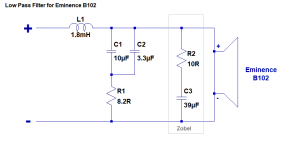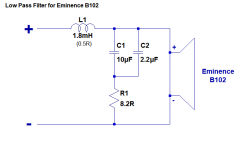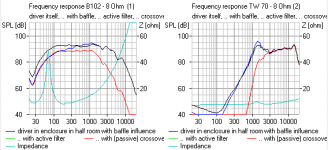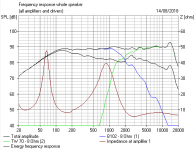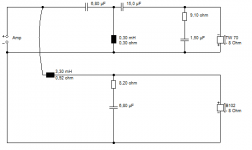Did you try covering the back of the horn with Blu Tak?That will certainly damp down resonances coming from the horn itself.
I did that on some KG4s.It made them sound quite different.
I owned a pair of JBL Studio 590s for a while.If you are interested in a 2.5 way speaker with a horn loaded tweeter they are really rather good.Certainly much more refined and less coloured sounding than the Klipsch.They also measure really well which was quite an achievement for an affordabe speaker of that type.They need a big room to sound their best though.
I did that on some KG4s.It made them sound quite different.
I owned a pair of JBL Studio 590s for a while.If you are interested in a 2.5 way speaker with a horn loaded tweeter they are really rather good.Certainly much more refined and less coloured sounding than the Klipsch.They also measure really well which was quite an achievement for an affordabe speaker of that type.They need a big room to sound their best though.
Have you tried stuffing the horn with acoustic foam or even poly-fill stuffing (claimed to reduce HOM -- see elsewhere on this site) and/or try the "towel trick", which more plausibly reduces the problem of mouth reflections? It is noteworthy that both of these tricks are as inexpensive and easy as they are hell on the speaker's appearance 
If you can bring yourself to accept 21st century conveniences, you can do remarkable shaping of any speaker's frequency response with digital EQ of many types. Or you can do it the old fashioned (crossover) way. Your choice.
If you can bring yourself to accept 21st century conveniences, you can do remarkable shaping of any speaker's frequency response with digital EQ of many types. Or you can do it the old fashioned (crossover) way. Your choice.
@bentoronto:
No disrespect intended. My inability to report results in a useful way was purely due to my incompetence and inexperience. I apologize. I will attempt to master REW again, but the last attempt ended in failure to get usable results, and that after hours of trying. I readily admit that I don't know what I'm doing.
I took a look through your thread on using a laptop mic for measurements. I bought an EMM6 mic a while ago, and have a suitable mic preamp with phantom power for it. I just need to put in the time to learn how to use it correctly with REW.
Ok, with that out of the way, the recordings where I heard the strange coloration of male baritone vocals:
"I Just Want To Sing" - Joe Williams & Friends, Delos Records (CD) -
Joe Williams - I Just Want To Sing - Amazon.com Music
The speakers are long gone, so I don't know for a fact if this would have demonstrated the problem, but I suspect it would have:
"Joe Williams Sings, Count Basie Swings... Standards"
Count Basie, Joe Williams - Count Basie Swings, Joe Williams Sings - Amazon.com Music
They sounded fine with female singers, but gave some extra thickness to the voice of Cassandra Wilson, as in "New Moon Daughter"
Cassandra Wilson - New Moon Daughter - Amazon.com Music. Cassandra Wilson's voice is on the deeper side.
At the time, I had a pair of Tannoy System 8 monitors for comparison, which have fairly flat frequency response. They did not exhibit the coloration I mentioned above.
Anybody with a pair of Klipsch KG4.5 or similar speakers and a different well-thought-of speaker that is known to have reasonably well-behaved midrange response could compare using these recordings and hear for themselves. I imagine a comparison with playback from Advent, B&W, KEF, Tannoy, etc. type speakers should do the trick.
I did not mean to trash these Klipsch speakers. I was desperately trying to like them. As I said before, it didn't work out. But as you've seen, I have the parts to try a new experiment. That should go in a different thread.
--
No disrespect intended. My inability to report results in a useful way was purely due to my incompetence and inexperience. I apologize. I will attempt to master REW again, but the last attempt ended in failure to get usable results, and that after hours of trying. I readily admit that I don't know what I'm doing.
I took a look through your thread on using a laptop mic for measurements. I bought an EMM6 mic a while ago, and have a suitable mic preamp with phantom power for it. I just need to put in the time to learn how to use it correctly with REW.
Ok, with that out of the way, the recordings where I heard the strange coloration of male baritone vocals:
"I Just Want To Sing" - Joe Williams & Friends, Delos Records (CD) -
Joe Williams - I Just Want To Sing - Amazon.com Music
The speakers are long gone, so I don't know for a fact if this would have demonstrated the problem, but I suspect it would have:
"Joe Williams Sings, Count Basie Swings... Standards"
Count Basie, Joe Williams - Count Basie Swings, Joe Williams Sings - Amazon.com Music
They sounded fine with female singers, but gave some extra thickness to the voice of Cassandra Wilson, as in "New Moon Daughter"
Cassandra Wilson - New Moon Daughter - Amazon.com Music. Cassandra Wilson's voice is on the deeper side.
At the time, I had a pair of Tannoy System 8 monitors for comparison, which have fairly flat frequency response. They did not exhibit the coloration I mentioned above.
Anybody with a pair of Klipsch KG4.5 or similar speakers and a different well-thought-of speaker that is known to have reasonably well-behaved midrange response could compare using these recordings and hear for themselves. I imagine a comparison with playback from Advent, B&W, KEF, Tannoy, etc. type speakers should do the trick.
I did not mean to trash these Klipsch speakers. I was desperately trying to like them. As I said before, it didn't work out. But as you've seen, I have the parts to try a new experiment. That should go in a different thread.
--
Last edited:
Did you try covering the back of the horn with Blu Tak?That will certainly damp down resonances coming from the horn itself.
I did that on some KG4s.It made them sound quite different.
Yes, I coated the back of the horns with duct seal (suggested by some for damping woofer baskets, etc.). It did help increase clarity. I didn't use Blu Tac, though. Perhaps that has properties that make it better for that use.
I think the tweeter was OK, but the crossover had some problems I was unable to solve.
I owned a pair of JBL Studio 590s for a while.If you are interested in a 2.5 way speaker with a horn loaded tweeter they are really rather good.Certainly much more refined and less coloured sounding than the Klipsch.They also measure really well which was quite an achievement for an affordabe speaker of that type.They need a big room to sound their best though.
I wound up with a pair of JBL LSR305 speakers, and I do like them a lot. I think they're insanely good for only $300 a pair, and they're self-powered to boot. Very cost-effective and reviews with measurements show they have impressively flat frequency response.
Studio 590 are $2000 USD a pair, which is in a completely different league. I'll bet they're really nice. I understand the 7 Series monitors are really good too. The 705P (5" 2-way, bi-amped active) is $2k a pair. There's a passive version as well.
Have you tried stuffing the horn with acoustic foam or even poly-fill stuffing (claimed to reduce HOM -- see elsewhere on this site) and/or try the "towel trick", which more plausibly reduces the problem of mouth reflections? It is noteworthy that both of these tricks are as inexpensive and easy as they are hell on the speaker's appearance
If you can bring yourself to accept 21st century conveniences, you can do remarkable shaping of any speaker's frequency response with digital EQ of many types. Or you can do it the old fashioned (crossover) way. Your choice.
Thanks for the suggestion, but I want to make clear that the Klipsch speakers are long gone.
I tried using a sheet of polyester batting lining the inside of the grille cloth, in front of the tweeter. (Being that it was behind the grille cloth, it didn't look bad.) It reduced the perceived tweeter 'hotness', which I liked. But the problem I couldn't fix (due to my own lack of ability and knowledge) was a problematic midrange coloration that showed up on deep-voiced male singers (like the jazz singer Joe Williams, although Billy Eckstine was also a baritone singer whose voice would be a good test for this).
What ruined me was when I borrowed a pair of QSC K10 speakers from a guy at work who was a DJ on the side. He let me take them home and try them for a weekend. They sounded exceptional, especially considering that they're PA speakers. I guess they were a little 'processed' sounding (due to the DSP?), but they were so much less colored than other speakers that I decided I needed to go down the powered monitor route, and try the much more affordable JBL LSR305s. I still have (and like) those.
Others' mileage may vary, greatly.
--
Last edited:
Closed box is just a natural for classical. You need low colouration, which usually means low efficiency. Low distortion and extended frequency response. All a bit Harbeth really.
Absolutely. But I've heard ported speakers do well for classical music too, like some Snell models. I've heard a system with Harbeth speakers (I don't remember which model) and yes, they're very very good.
I'm not sure you can do this with PA drivers. Much as I love the liveliness of high efficiency. And, TBH, anything you do in two-way is better in a three-way.
I was looking at Jeff Bagby's Fusion-8 Alchemy. It's a bit more sophisticated than Eminence crossovers, being third order bass around 2.5mH/8uF/1mH, and crossing at about 2.5kHz, well below the Beta 8A's breakup. Second order tweeter with attenuator. It must help to get well away from breakup. I suppose the only way to find out, is to build something.
Funny you should mention that speaker. I've been looking at that as well, because it's affordable. The folks at diysoundgroup told me that they absolutely would need to be used with a subwoofer (or two), since they don't employ much in the way of baffle-step correction, and have a claimed F3 of 65Hz. Here are measurements from one builder:
That doesn't look like it would go low enough to be used as a standalone stereo pair.
One of the things I've read stated that deeper-throated horns like tractrix or exponential flares are designed for longer 'throw', and are not what you want for near-field listening in a small or medium-sized room. However, these new-fangled oblate-spheroid or round 'waveguides' are quite shallow, and so don't focus the horn 'beam' so tightly. If I understand the graphs correctly, they restrict dispersion some, but not as tightly focused as exponential or tractrix flares. If the LSR305 is any indication, I'd say they sound quite different from the exponential and tractrix horns I've heard. Unfortunately, the SEOS and other oblate-spheroid waveguides don't have the flat amplitude response of a tractrix horn, and so need considerable EQ. Designing that in is far beyond my skills.
I was looking at the Econo-wave threads, hoping I could graft something from there onto the Eminence B102 woofers. Should be possible...
Last edited:
If I see one thing wrong with the Klipsch 4.5, it is a lousy crossover. That's it really. What do you expect in a cheapish speaker? Can't comment on the drivers since we have no measurements, and I know very little about horns.
There are only two ways to go on second order bass filters.
Your typical 2mH/10uF Eminence style which works with lowish inductance woofers. Notches optional.
Humble Homemade Hifi - Twenty Five
Or coil and near Zobel impedance correction which works with most woofers. Notches optional.
TQWT-
Interestingly, Lynn Olson is not convinced that classical music is good with the PA approach either:
Beyond the Ariel
I have always found higher order filters work best for demanding music. THe best sounding speakers I have built always have fourth order electrical on the tweeter. Bass, well second order can work for LR4 acoustic because they have a natural rolloff anyway. Might give you some ideas anyway.
There are only two ways to go on second order bass filters.
Your typical 2mH/10uF Eminence style which works with lowish inductance woofers. Notches optional.
Humble Homemade Hifi - Twenty Five
Or coil and near Zobel impedance correction which works with most woofers. Notches optional.
TQWT-
Interestingly, Lynn Olson is not convinced that classical music is good with the PA approach either:
Beyond the Ariel
I have always found higher order filters work best for demanding music. THe best sounding speakers I have built always have fourth order electrical on the tweeter. Bass, well second order can work for LR4 acoustic because they have a natural rolloff anyway. Might give you some ideas anyway.
A super gracious reply. Thanks....and that after hours of trying.
Yes, REW is at first a steep learning curve. Once set, easy to use. Hope you'll persevere.
I use a second-hand mic mixer (a million cheap ones out there), long cables, $4 DAC from the Salvation Army store, and an inexpensive Parts Express mic stand.
After decades of painstaking plots with a Heath audio oscillator and graph paper, REW is one of the greatest non-human benefits in my life.
B.
If I see one thing wrong with the Klipsch 4.5, it is a lousy crossover. That's it really. What do you expect in a cheapish speaker? Can't comment on the drivers since we have no measurements, and I know very little about horns.
The compression drivers were very small and light. Nothing anywhere near the heft of a Selenium D220ti or similar. The woofers were typical 1990s foam-surround, stamped basket drivers; grey plastic (probably polypropylene) cones. Still, the speaker system had an attractive sound with exciting dynamics. Just some problems that popped up and spoiled enjoyment of some recordings, which just happened to be recordings I like to listen to.
There are only two ways to go on second order bass filters.
Your typical 2mH/10uF Eminence style which works with lowish inductance woofers. Notches optional.
Humble Homemade Hifi - Twenty Five
Sounds like a good place to start. I have a pair of good quality 1.8mH coils on hand. Maybe 1.8mH/12uF? I have suitable capacitors available.
Or coil and near Zobel impedance correction which works with most woofers. Notches optional.
TQWT-
That's something like what I was using with the B102. I had 1mH series L but with no parallel RC, and a zobel network of 10R-10uF.
Interestingly, Lynn Olson is not convinced that classical music is good with the PA approach either:
Beyond the Ariel
For violins, etc., I don't think I've ever heard a speaker with exponential flare horns (Altec A7, Klipsch Heresy, Klipsch KLF20) that I could live with long-term, EXCEPT a pair of Klipschorns. Those were pretty amazing. But those are also huge and expensive, and require a room with full corners, which mine lacks. I need to hear a pair of Klipsch La Scala set up well. People seem to like those a lot, and not just for rock music.
The shallow 'waveguides' you see these days sound very different to me from the exponential and tractrix flares in classic speakers, which were designed for long-throw behavior. Today's waveguides are much shallower, not meant to project sound out tens of meters to the back row.
I find that these JBL LSR305 sound quite pleasant on orchestral music, string quartets, solo piano, lieder, etc. There's a very nice precision and clarity to them, while not being 'squawky'. Treble dispersion falls off rapidly to the sides (controlled dispersion), which probably helps with imaging and frequency response in-room. They are cheap speakers, though, so there is some mud in the lower mids. But really, they're $300 USD a pair, electronic crossovers and amps included. Flat on-axis frequency response and well-controlled dispersion must be desirable attributes if they can make these cheaply built speakers sound so pleasing.
FWIW, Earl Geddes measured the LSR308 (8" 2-way version) and came out stating that it's an amazing speaker for the money.
YouTube
I have always found higher order filters work best for demanding music. THe best sounding speakers I have built always have fourth order electrical on the tweeter. Bass, well second order can work for LR4 acoustic because they have a natural rolloff anyway. Might give you some ideas anyway.
Thanks for all this, really!
I suppose I could try a 4th order HPF, see how it goes. I think getting a reasonable REW-based measurement system going is the first task at hand, although I might drag the B102 monkey coffins out and spend a few hours playing with crossovers....
--
Last edited:
..If the LSR305 is any indication, I'd say they sound quite different from the exponential and tractrix horns I've heard. Unfortunately, the SEOS and other oblate-spheroid waveguides don't have the flat amplitude response of a tractrix horn, and so need considerable EQ...
The reason that expo and tractrix have 'flatter' response is because they puts the higher frequencies into a narrow beam -- same energy into less space makes more pressure. So they are only flatter directly on axis and are quite non-flat off axis and for room ambience. SEOS and other constant directivity waveguides aim for the same coverage angle over all their working frequencies, giving a flatter power response in the room. The compression drivers used by horns have a natural 'mass rolloff' due to their diaphragms, and constant directivity horns give the same response as the drivers have.
Perhaps you can help our friend with the horn side of the project?The reason that expo and tractrix have 'flatter' response is because they puts the higher frequencies into a narrow beam -- same energy into less space makes more pressure. So they are only flatter directly on axis and are quite non-flat off axis and for room ambience. SEOS and other constant directivity waveguides aim for the same coverage angle over all their working frequencies, giving a flatter power response in the room. The compression drivers used by horns have a natural 'mass rolloff' due to their diaphragms, and constant directivity horns give the same response as the drivers have.
1.8mH and 12uF looks useful to me as a bass filter on a Eminence Legend B102 10":
That's what it does with a Mivoc 92dB PA driver used by marco_gea, who is a top man.
http://www.diyaudio.com/forums/multi-way/147632-classic-monitor-designs-25.html#post4428857
Edit. I was just looking at the fairly hefty inductance of the Legend B102. 60 ohms at 10kHz is a lot, and is probably why the FR is so level. It's gonna fight the filter into a peak at crossover. I think you might need 4.7R upwards to 7.5 ohms in series with the 12uF capacitor. Rats!
Last edited:
Edit. I was just looking at the fairly hefty inductance of the Legend B102. 60 ohms at 10kHz is a lot, and is probably why the FR is so level. It's gonna fight the filter into a peak at crossover. I think you might need 4.7R upwards to 7.5 ohms in series with the 12uF capacitor. Rats!
Ah, so you can infer the VC inductance from the impedance curve. Ah ha...
Would a zobel network have much influence on that? Something like 10R-10uF?
Thinking about that some, I figure the high voice coil inductance would store energy, and fight the filtering action of the crossover. Would it make more sense to 'go with the flow' and use a shallow acting 1st order LPF (a single series inductor)? Since the speaker will need some baffle step correction anyway, a bit of midrange suckout might work to advantage. If done exactly right, of course.
I've been running around, dealing with bills, etc. today, so haven't brought the monkey coffins out into the living room yet.
As a first stab, I guess I could rig up an external crossover board, using a 1.8mH/13uF LPF, with either 4.7R or 8.2R resistors in series with the 13uF. With that in place, I'd want to apply a sine wave sweep, and watch out for a peak in response in the area around 1kHz to 3kHz, right?
--
edit to add:
I also have a pair of Dayton PA255-8 at my disposal.
https://www.parts-express.com/pedocs/specs/295-030-dayton-audio-pa255-8-specifications-46882.pdf
The published impedance curve shows 28R at 10kHz. I don't know if that makes much of a difference. The frequency response curve shows a weird dip centered at 760Hz, which is a bit off-putting.
Last edited:
The RC Zobel is designed to match the Rdc and Inductance of the woofer.
Because a dynamic speaker has mechanical loss to add to the electrical resistive loss the compensating resistance is 25% more. With a 6.9R Legend that is, er, 8.2 or 9.1R.
Because I know my way round Zobels, I would guess 60 ohms at 10kHz needs 39uF. I usually sim these things for a flat impedance.
So 10R plus 39uF would be close enough IMO. You'd use that with 1mH for about 2kHz crossover or -6dB point.
But this is not the only way to do this. 1.8mH and a shunt of 8.2 and 12uF would get you to much the same place with a regular less flat impedance and some 2dB of bafflestep and slightly steeper slope on the bass rolloff.
I'd just listen to it. You can hear a peaky vocal as rather shrill on the high notes of a female singer.
The Dayton is much lower inductance, of course. Maybe half. It is why it is not so flat too. But that is mission creep IMO. It makes me feel tired to think about it.
Because a dynamic speaker has mechanical loss to add to the electrical resistive loss the compensating resistance is 25% more. With a 6.9R Legend that is, er, 8.2 or 9.1R.
Because I know my way round Zobels, I would guess 60 ohms at 10kHz needs 39uF. I usually sim these things for a flat impedance.
So 10R plus 39uF would be close enough IMO. You'd use that with 1mH for about 2kHz crossover or -6dB point.
But this is not the only way to do this. 1.8mH and a shunt of 8.2 and 12uF would get you to much the same place with a regular less flat impedance and some 2dB of bafflestep and slightly steeper slope on the bass rolloff.
I'd just listen to it. You can hear a peaky vocal as rather shrill on the high notes of a female singer.
The Dayton is much lower inductance, of course. Maybe half. It is why it is not so flat too. But that is mission creep IMO. It makes me feel tired to think about it.
Thanks again for the ideas.
OK, no mission creep. Please ignore the Dayton reference.
A nominal 2kHz crossover made from 2nd order electrical LPF of 1.8mH with shunt of 12uF (or 10uF||2.2uF) and 8.2R in series it is. I'll give it a listen. That's Experiment #1.
Were you thinking the above is to be done without the Zobel network?
OK, no mission creep. Please ignore the Dayton reference.
A nominal 2kHz crossover made from 2nd order electrical LPF of 1.8mH with shunt of 12uF (or 10uF||2.2uF) and 8.2R in series it is. I'll give it a listen. That's Experiment #1.
Were you thinking the above is to be done without the Zobel network?
I've got the soldering iron warmed up. Starting in on the LPF for the B102. Just wanted to make sure I'm doing this right. Attached schematic is of the LPF I'm aiming for, correct?
I will have to build up the 13uF caps from a 10uF 100V Panasonic metallized film, a Wima MKT 2.2uF 250V, and some kind of 1uF metallized film something or other.
What happens if C3 is 33uF instead of 39uF? Or would it be better to make it 47uF? I have to see what kind of non-polarized electrolytics I have in my drawers.
Oh, and the 1.8mH inductors' DCR is 0.5 ohm. Does that change anything?
I will have to build up the 13uF caps from a 10uF 100V Panasonic metallized film, a Wima MKT 2.2uF 250V, and some kind of 1uF metallized film something or other.
What happens if C3 is 33uF instead of 39uF? Or would it be better to make it 47uF? I have to see what kind of non-polarized electrolytics I have in my drawers.
Oh, and the 1.8mH inductors' DCR is 0.5 ohm. Does that change anything?
Attachments
Last edited:
That won't work at all:
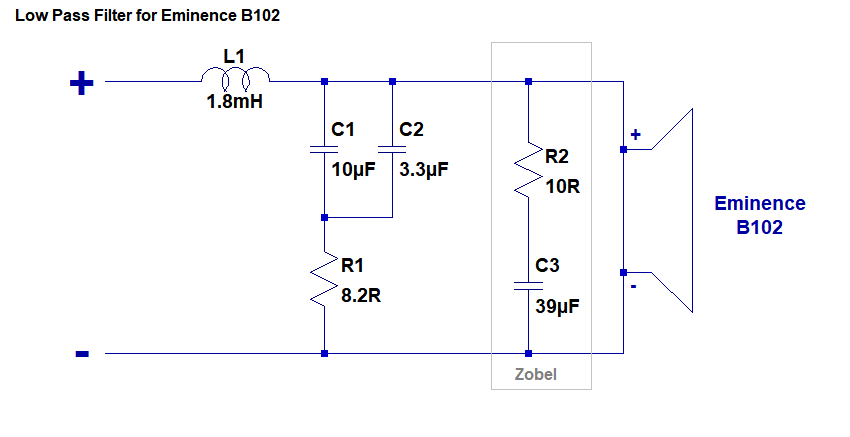
You don't need a Zobel with the regular 1.8mH series and shunt of 8.2R and 12uF for approx. 2kHz -6dB point. I would call that first order with a bit of impedance correction.
Using a full Zobel is an entirely different ballgame. It works with textbook values from those online calculators: 2-Way Crossover Calculator / Designer
What the Zobel style doesn't do is take care of bafflestep. Resulting in a bass light sound. For that you must add an RL parallel network: Seas ER18RNX with 27TDFC
So I would start here with 1.8mH series, 8.2R and 12uF shunt. It's a good sounding circuit for tidy woofers in the AllenB tune by ear style. None of these values are very critical.
You don't need a Zobel with the regular 1.8mH series and shunt of 8.2R and 12uF for approx. 2kHz -6dB point. I would call that first order with a bit of impedance correction.
Using a full Zobel is an entirely different ballgame. It works with textbook values from those online calculators: 2-Way Crossover Calculator / Designer
What the Zobel style doesn't do is take care of bafflestep. Resulting in a bass light sound. For that you must add an RL parallel network: Seas ER18RNX with 27TDFC
So I would start here with 1.8mH series, 8.2R and 12uF shunt. It's a good sounding circuit for tidy woofers in the AllenB tune by ear style. None of these values are very critical.
Simple is good -- and certainly for me! I think, though, that I'm not seeing the subtleties. Does this juggling of L vs. C values in what looks like a straightforward 2nd order filter add a bit of baffle-step compensation? Or is that what the 8.2 ohm resistor is doing, in series with the shunt capacitor?
OK, no Zobel. I can build up the 12uF with the 10uF and 2.2uF caps I have.
For the record, the attached schematic is the target now.
--
OK, no Zobel. I can build up the 12uF with the 10uF and 2.2uF caps I have.
For the record, the attached schematic is the target now.
--
Attachments
Last edited:
That's a fat lot of help!I'd knock the peak down it you can, 2.8khz if i remember.
I have amazed myself and got some sort of sim of the B102 working!
Speaker Detail | Eminence Speaker
I have really no idea what I am doing with an SPL trace and importing it into Boxsim, but what I am getting is not unreasonable after much fudging. The FR and impedance does look like the Eminence measurement which must be infinite baffle.
The 1.8mH/8.2R+12uF comes out a bit bass light on 2kHz crossover.
I think we need a bigger coil here. Here's what I get for 60L tuned to 25Hz on a 25cm. baffle width, which is a wild guess in itself. I am, of course, waiting for the horn expert to tell us how to do that part.
Attachments
- Home
- Loudspeakers
- Multi-Way
- Trying to mellow out Klipsch KG 4.5 tractrix horn
